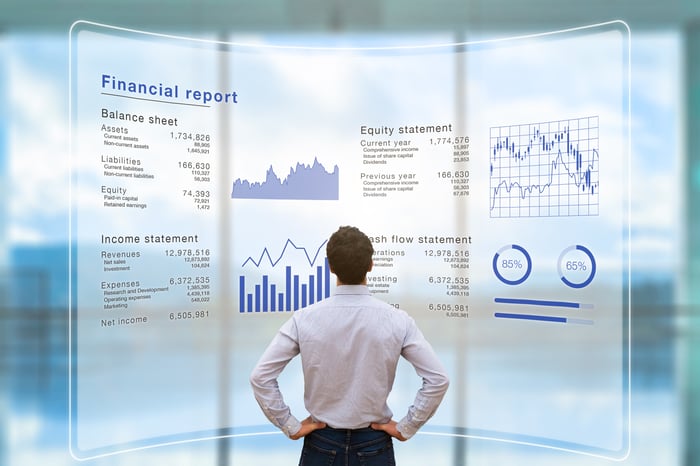With interest rates still near all-time lows, yield-starved investors are looking to stocks as a way to provide income from their investments. Although it's fairly easy to find stocks that yield more than the paltry 2.4% recently offered by long term Treasuries, stock dividends come with a huge risk attached. Dividends are never guaranteed payments, and as 2020 taught us, when the going gets really tough, even the best investors can see their dividend streams get slashed.
As a result, when seeking out investment income, it's incredibly important to look beyond the headline yield numbers and focus on the fundamentals supporting those payments. By digging a bit deeper, you can potentially uncover stocks that not only pay decent dividends today, but also have the chance to sustain and grow those dividends over time. With that in mind, here are some key strategies on how to find the best dividend stocks.

Image source: Getty Images.
Figure out how well those dividends are covered
Companies that pay cash dividends first need to come up with that cash. There are basically two ways they can do that. They can either generate that cash from their operations or they can liberate cash from their balance sheet. Handing over balance sheet cash might work for a little while, but it is in no way a sustainable plan for a company to return money to its owners. Sustainable dividends get paid from a company's operating cash flows.
It's fairly straightforward to find a company's payout ratio from most financial sites. The payout ratio looks at how large a company's dividend payment is compared with its accounting earnings. That number is a good way to screen companies, but it's quite possible for earnings and cash flows to tell different stories.
What you're looking for is something of a "goldilocks zone" of coverage. You want coverage that is strong enough that the company is capable of continuing to pay its dividend even if it runs into some short-term troubles. At the same time, you want the dividend payment itself to be a large enough part of the company's operations that it takes it seriously and shows a decent commitment to it.
Look for a solid balance sheet

Image source: Getty Images.
When things are going well for a business, it can be easy to overlook its balance sheet. When things turn sour, on the other hand, the balance sheet might be the key difference maker between giving it enough time to work through the issues or it being consigned to the dustbin of history.
A balance sheet looks at what a company owns and what it owes. The larger its assets (the stuff it owns) compared to its liabilities (how much it owes), the stronger that balance sheet is. In a pinch, a company can sell its assets to help satisfy its liabilities. In more common situations, lenders look at how strong a company's balance sheet is in determining whether to extend or renew credit.
Things to look for include its cash level (the more the better), its current ratio (the higher, the better), and its debt-to-equity ratio (the lower the better, as long as it's zero or above). In addition, if the company has long-term debt, check when that debt matures. Ideally, you'll want a spread out maturity schedule or any big maturities to be far out in the future.
Check on its dividend history
Although the past is no guarantee of the future, when it comes to dividends, what it has done in the past tells a lot about how committed a company is to rewarding its owners. If a company can consistently raise its dividend while keeping its balance sheet strong and its payout ratio reasonable, that says a lot about both the strength of its business and its commitment to its shareholders.
In addition, if a company had to cut its dividend -- such as due to the financial crisis or the coronavirus pandemic -- how quickly it builds that dividend back up also speaks volumes. It showcases just how deep the pain was that caused the cut and how confident the company's leadership is that the business is really recovering. In addition, whether or not the dividend recovers -- and how quick it does -- says a lot about just how resilient the underlying business model really is.
Understand how the business makes its money
Companies that reliably pay dividends tend to either be structured in a way that requires them to pay dividends or have business models that help entrench their cash flows in some way. It's important to recognize how a company is able to pay its dividends and why those dividends look to be sustainable.
That way, you can keep an eye out for possible disruptions to those cash flows before they get big enough to actually derail the company and its dividends. After all, dividends are never guaranteed payments, and a company's cash flows have to be there for those dividends to be sustained.
Quality is at least as important as quantity
In today's low interest rate environment, dividend stocks can potentially provide better income than many bonds can, but there is clearly a catch attached. Since divided payments are never guaranteed, you need to look beyond the headline payment amount to try to figure out the quality of that dividend.
When it comes to dividend sustainability, that quality is at least as important as how large the payment is. With a good handle on a company's dividend coverage, payout ratio, balance sheet strength, dividend history, and how that business makes its money, you can typically get a great feel for that quality. That can help you find the best dividend stocks.




